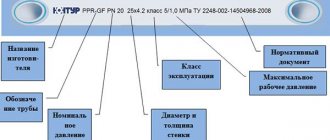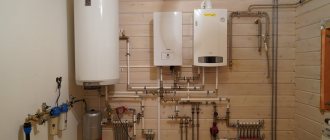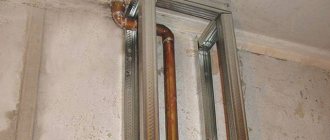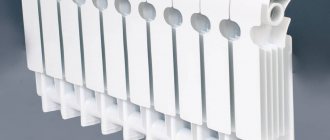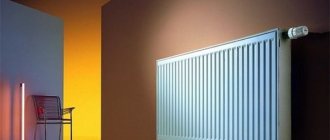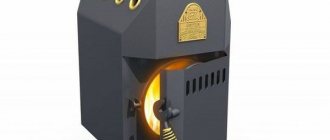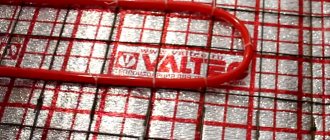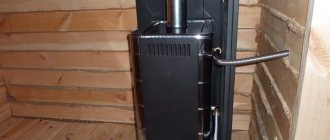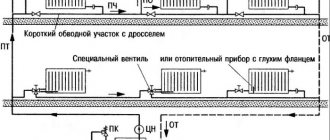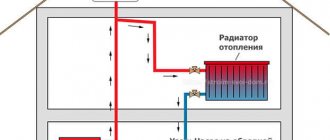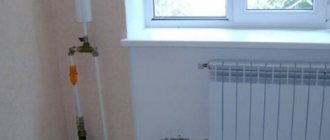Polypropylene pipes are used in cold and hot water supply, heating, and even in systems for pumping chemicals in the oil and gas industry. Such a wide range of applications is due to the excellent set of material characteristics. Polypropylene is not subject to corrosion, does not rot, is quite durable and is not chemically active with most compounds. However, there are a number of features that should be taken into account when planning to use polypropylene pipes for heating.
Types of polypropylene pipes for heating
Polypropylene as a material is not resistant to high temperatures. Therefore, different PP pipes are used to move cold and heated water. They differ in the type of polymer used in their manufacture.
To ensure that the building outline is thermally stable and does not deform during operation, a special PP heating pipe is used. It is made of polypropylene with the addition of ethylene and is designated PP-R.
Marking of PP pipes
To increase resistance to high temperature loads and pressure, PP products are additionally reinforced. Strengthening of products is carried out using:
- aluminum foil placed on the surface or between layers of polypropylene;
- fiberglass, which allows the production of monolithic products that do not delaminate during installation processes and operation.
Before installation, aluminum-reinforced PP pipes are carefully cleaned and trimmed to prevent delamination in the connected areas. Products with a layer of fiberglass do not require such preparation.
Both types of multilayer products have a long service life. For example, in comparison with conventional PP pipes used in the construction of heating or hot water supply systems.
Heating pipelines are not installed when using PVC and HDPE products, because polyvinyl chloride and low-density polyethylene are soft materials. Moreover, polypropylene surpasses them in characteristics and is lighter in weight.
Pipe marking
Pipes are marked with a certain abbreviation of three Latin letters:
- The PPH marking is assigned to plastic made from homopolymers. This is polypropylene, which consists of the smallest completely identical structured units. Such elements are only suitable for carrying cold water into the house.
- The designation PPV indicates that the parts are made from block copolymers. This is a component of a complex structure with a systematic alternation of different structural homopolymers. Products made from this material can be used for water supply and in underfloor heating systems.
- A stamp marked PPR is placed on products made from random copolymer, which has a high level of crystallization and is ideal for heating.
Comparative characteristics of plastic pipes and components with approximate prices. Prices are in euros
If you are planning to carry out heating in a private house with your own hands, choose only pipes marked PRR!
Characteristics of PPR plastic
Pipes marked with the abbreviation PPR have the following characteristics:
- Long service life;
- Good sound absorption when water flows;
- Resistance to pressure changes and temperature conditions;
- Light weight;
For heating needs, pipes marked PPR are used - Corrosion does not form upon contact with water;
- Minimum installation time compared to installation of metal pipes;
- Compliance with sanitary standards of GOST, standards of leading world powers.
Specifications
Resistance to various factors affects the properties of PP products.
Fragment of the heating system
The main characteristics of the products include:
- Maximum permissible pressure depending on the temperature of the transported medium. As it increases, the maximum value of this parameter decreases. PP pipes generally withstand from 4 to 6 atm if the coolant temperature is 70 °C.
- Thermal stability, allowing to withstand short-term increases in the temperature of the transported medium up to a maximum of 95 °C. This happens extremely rarely in the heating circuits of residential buildings. The material begins to soften at 110-140 °C, and melt at 140-170 °C.
- Low heat conductivity, preventing the appearance of condensation on the pipeline. Thanks to this characteristic, its surface and the moving coolant will have almost the same temperature.
- Resistant to corrosion. It manifests itself as a lack of response to exposure to water. PP pipes have a smooth inner surface. Therefore, salts do not accumulate in them. This allows them to compete adequately with other types of pipes.
- Service life is about 50 years. It exceeds the durability of steel products by almost 2 times. This property of PP products depends on the heating scheme, operating pressure and temperature changes of the transported medium.
Features of polypropylene pipes
The main feature of polypropylene is resistance to high temperatures, and additional reinforcement is designed to protect it from expansion when heated. Due to the special hardness of the material, the pipes have a perfectly smooth surface, which has a positive effect on their high resistance to corrosion and the influence of external factors.
Using polypropylene pipes for heating, taking into account the characteristics of the material and size, they not only install internal networks, but also main ones.
Advantages
The popularity of polypropylene pipes is due to the following advantages:
- withstand pressure more than 10 Bar;
- aesthetic appearance;
- not subject to corrosion, not electrified;
- smooth inner surface prevents dirt from settling;
- attractive price;
- the chemical purity of the material allows it to be used in the food industry;
- ease of transportation, transportation is possible in bays.
Flaws
Disadvantages of polypropylene:
- does not tolerate direct exposure to ultraviolet radiation, under the influence of which it is quickly destroyed, additional protection is required;
- at high temperatures it begins to melt;
- installation requires a special welding machine;
- difficulty in repair work and maintenance.
Selection parameters: diameter and marking
When creating heating with polypropylene pipes, their diameter must be taken into account. This is the main parameter depending on the pressure and flow rate of the coolant.
PP pipes for heating of different diameters
First criterion
When installing the network, pipes with the following diameter are used:
- Up to 16 mm - used for installing heated floors. They are used together with fittings, as they lack flexibility.
- 20-25 mm - used when installing heating in cottages and apartments. When installing horizontal wiring, products with a diameter of 20 mm are used, and for risers - PP pipes with a cross-section of 25 mm.
- 25-32 mm - used when installing central heating systems in high-rise, multi-apartment buildings.
- More than 200 mm - used for the installation of heating networks in large shopping and entertainment centers, educational, medical, educational and other institutions.
Second criterion
It is necessary to take into account not only the diameter, but also the marking of polypropylene heating pipes. According to accepted rules, the following designations are used for pipe products made from this polymer:
- PN10 - can withstand a pressure of 1 MPa, if the DHW water temperature is 20 °C, and in the “Warm Floor” system does not exceed 45 °C. For pipes with this marking, the maximum wall thickness is 10 mm. Therefore, they are not used when installing heating in houses and apartments.
- PN16 - allowing to move coolant with a pressure of maximum 1.6 MPa when its temperature does not exceed 60 °C. Tubular products of this type are produced with walls no less than 3.4 mm thick. If the temperature changes sharply, their service life is often reduced. Therefore, when installing a heating system in residential premises, pipes with higher performance are used.
- PN20 - designed for a pressure of 2 MPa if water heated to 80 °C is delivered. Pipes of this type are used in the construction of hot water supply networks when their wall thickness is from 16 to 18.5 mm.
- PN25 - created for a pressure of 2.5 MPa. They are produced only in reinforced versions and are used for heating various objects.
Which PPR pipes are suitable for heating
Polypropylene pipes began to be used for heating systems relatively recently. Before this, their place was taken by solid steel pipes. Such structures were connected by welding, were durable, but difficult to install and expensive to manufacture.
Polypropylene pipes have gone through a number of important metamorphoses over their short history. Polypropylene itself does not have the heat resistance that the companies developing it expected. That is why the first heat-conducting systems with such pipes quickly fell into disrepair, and they began to be skeptical about the material itself.
At the moment, polypropylene pipes have been significantly improved. There are various models that are used to supply cold and hot water, heat supply and sewage disposal. When carrying out repairs, it is important to choose pipes that are designed for specific purposes, otherwise the structure will not be suitable for use.
It is important! At the moment, there are many companies producing and selling pipes for heating systems. It is advisable to buy pipes along with all components from official suppliers in specialized stores, since there are many low-quality fakes.
Types of PPR pipes
Polypropylene pipes are used in various areas, but not all are suitable for heating. In pursuit of cheap material, you may buy the wrong type of pipe that could withstand hot water under pressure. It is important to be able to distinguish one type of pipe from another.
The classification of polypropylene pipes is as follows:
- RR-N. This is the first generation of polypropylene pipes. This model has all the properties of the base material. PP-N are hermetically sealed and resistant to high pressure, in addition, they do not enter into chemical reactions. However, melting of such a pipe can begin already at a temperature of 50 ͒ C. Such pipes are used in cold water supply systems, ventilation and for industrial purposes;
- RR-V. During the production of this type, the formula of the material was slightly changed. The pipes turned out to be stronger and more durable, but they still could not withstand temperature fluctuations. Such pipes have the advantages of previous generation and, in addition, better withstand the effects of hot temperatures. However, they are unsuitable for heating systems and even hot water supply. Such pipes are often used in sewer construction;
- PP-R. In the production of these pipes, in addition to polypropylene, ethylene is used. This allows them to withstand high temperature loads. In addition, such pipes, as a rule, are reinforced, which allows them to withstand temperatures of more than 100 ͒ C. Reinforced PP-R pipes are the most suitable option for a heating system.
We recommend that you read: How to select and install a compensator for greater reliability of systems made of polypropylene pipes
Reinforced pipes
Reinforcement is the process of covering a pipe with a material that, in terms of strength or other properties, is superior to the main material of the structure. In the case of polypropylene pipes, reinforcement means coating the pipe with metal, which retains heat and prevents pipe deformation under the influence of high temperatures. Reinforcement can be of two types:
- Aluminum. In this case, the surface of the pipe is covered with aluminum foil. Sometimes such foil is embedded between layers of polypropylene. Aluminum does not allow PPR to expand and change its shape. However, such pipes have one significant drawback - they can delaminate. Delamination occurs if the pipe is made of low-quality materials or is improperly joined to another pipe;
- Fiberglass. This coating is woven between layers of polypropylene. This makes the delamination process impossible. Such pipes are integral and do not deteriorate due to improper installation or operation. The service life of PPR with fiberglass coating is longer, however, such pipes are more expensive.
Technical characteristics of heating pipes
The characteristics of pipes are based on resistance to various factors that act during operation. When choosing pipes for a heating system, you need to pay attention to the following parameters:
- High pressure resistance. Reinforced polypropylene pipes can withstand a system pressure of 6 atm. at a temperature of 70 ͒C. The higher the temperature, the less resistance to pressure. In the heating system, hot water is not supplied at maximum pressure;
- Temperature resistance. Polypropylene pipes with reinforcement begin to melt at a temperature of 120 ͒ C. In the heating network, the temperature rarely exceeds 70 - 75 ͒ C, which creates a reserve of heat capacity in the system. PPR can withstand frost worse than heat;
- Non-corrosive. The main disadvantage of metal pipes is the possibility of reacting with water. Sooner or later, such pipes rust and cease to be airtight. Polypropylene does not corrode when exposed to water. Moreover, it does not react with salts and other impurities that may be found in the system;
- Durability. Manufacturers promise a pipe service life of half a century, but do not give guarantees. In fact, the durability of the structure depends on the type of reinforcement, the correct installation, the temperature inside and outside the pipes, and the pressure in them. If you follow all the recommendations, you can forget about repairs for several decades.
It is important! Polypropylene pipes can be installed outdoors only for residents of the southern regions. When the temperature outside the system is less than -15 ͒ C, polypropylene becomes brittle and pipes may break. Such designs are only suitable for pipelines located indoors.
Selection of heating pipes
For heat pipes, it is better to give preference to polypropylene with fiberglass reinforcement. However, pipes made of this material are also different. They vary in diameter and ability to withstand a certain pressure in the system. The following categories of pipes are distinguished by diameter:
- Less than 1.6 cm. Such pipes are suitable exclusively for underfloor heating systems. This diameter should be sufficient if the pipes are installed correctly;
- 2.0 - 2.5 cm. The most popular diameter when installing heating in a house or apartment. For the riser that goes into the apartment, a diameter of 25 mm is required, and pipes of 20 mm are installed in the rooms;
- 2.5 - 3.2 cm. This category is used in multi-storey buildings with centralized heating;
- More than 20 cm. Pipes of this diameter are needed for large organizations. For example, hospitals with many departments, wards and offices.
We recommend that you read: PVC pipes for swimming pool equipment
It is not difficult to determine the pressure that the pipes can withstand. Just look at the PN marking and the number after it. Thus, PN 10 can withstand a pressure of 10 atmospheres at a temperature of 45 ͒ C, PN 16 - 16 atm. at a temperature of 60 ͒ C, PN 20 - pressure 20 atm. at a temperature of 80 ͒ C, PN 25 - 25 atm. at a temperature of 100 or more ͒C. For the heating system, you must choose at least PN 16, preferably PN 25.
Thus, the best option for heating pipes is fiberglass-coated polypropylene pipes with a diameter of 2 - 2.5 cm and marked PN 25.
Features of installation in an apartment
If it is necessary to replace heating pipes in an apartment, the type of system is first determined. It can be a one-pipe or 2-pipe network.
The quality of heating, the length and size of pipe elements, and the number of fastening fittings depend on the type. If a 2-pipe system is installed in an apartment and more than 8 radiators are installed, pipes with a diameter of 32 mm are used.
PP pipes for heating in an apartment
The installation of a single-pipe network is cheaper, but in each subsequent battery the coolant temperature will be lower compared to the previous radiator. To reduce this effect, thermostats are used. They regulate the power of each battery.
When installing a one-pipe or 2-pipe system, Mayevsky taps must be used to remove air pockets. They are installed at the top of the radiators.
Unused holes in the batteries are sealed with plugs. They are usually sold separately from the main equipment.
The specific heating scheme determines the type and number of fittings and clamps used. Soldering is performed using special equipment. The heating time of PP pipes is observed depending on the cross-section. For products with a diameter of 25-32 mm, heating is carried out for 7-8 s.
The work is carried out in the following order:
- The event is coordinated with residents living on the floor below and above so that the entire riser can be completely replaced. If this is not possible, transition couplings are used to connect pipes made of steel and polypropylene.
- The installation process is coordinated with utility services for the possibility of shutting off and discharging the coolant.
- The old system is being analyzed.
- Radiators are being installed.
- PP pipes are laid with connection to the batteries.
- The tightness of the new thermal circuit is checked at a pressure of one and a half times the operating value.
Is it possible to install polypropylene pipes for central heating?
And first of all, we will answer the most important question, is it possible or not. It would seem that the answer is obvious, because polypropylene today is widely used both in the repair of old heating systems and in the installation of heating in new buildings. But in fact, installing polypropylene pipes in central heating systems is a serious miscalculation, which over time can result in big troubles for you. Moreover, even many specialists take such risks, simply for the sake of savings and ease of installation.
What's the matter? Note that the current SNiP allows the installation of polypropylene pipes suitable for such systems on central heating. However, if you think about it, this norm is far from Russian reality. What is the maximum heat resistance of polypropylene? Ninety-five degrees Celsius, beyond that the pipes begin to bend and sag. And the maximum working pressure is twenty-five atmospheres. What happens in centralized heating systems? Yes, it seems that the standard parameters of these pipes are suitable for central heating. After all, the temperature in the networks is limited by current standards, and cannot be higher than the specified ninety-five degrees. And the pressure in the system is usually in the range from four to seven atmospheres.
We recommend: What is included in heating system maintenance?
However, there are several “Buts”. Firstly, for some reason we always forget about force majeure, which is common in our country, that is, unforeseen situations when the standard parameters of the system can be exceeded, and significantly. Let's look at a few possible problems:
- Even in central Russia, severe frosts are not uncommon in winter. The walls of our houses do not always retain heat well enough. And even more so in a high-rise building you need to heat it harder to warm up the top floors. But in severe frosts, sometimes 95 degrees is not enough. And therefore, in order not to listen to residents’ complaints, heating workers sometimes take extreme measures. The nozzle in the elevator unit of the house is dismantled, and the elevator suction is muffled. What does this give? You can simply supply hot water to the system directly from the heating network, and not a mixture of supply and return, as required by regulations. However, at the peak of cold weather, the temperature of such a coolant can reach even one hundred and fifty degrees. What will happen then to your polypropylene pipes?..
- Let's not forget about the annual testing of the heating heating main. The pressure in the system is artificially increased to test its strength and to identify the most worn areas of the pipes. All this, of course, is good, but will your reinforced polypropylene withstand such a test?.. In addition, it is possible that the utility workers are experienced, the shut-off valves are faulty, and the pressure in the system can rise significantly. Although the heating must be turned off during the test;
- Another possible problem is water hammer. As you know, water is almost not compressed, and therefore, when the circuit is quickly filled and circulation is instantly stopped for a few moments, the pressure in the system can reach 25-30 atmospheres, which exceeds the permissible standards even for polypropylene with a reinforcing insert. And the consequences for such pipes are quite predictable.
And one more subtlety. The maximum pressure indicated on such pipes is 25 kgf/cm2. However, this is the maximum permissible pressure at room temperature of plus twenty degrees. But at elevated temperatures, the strength of polypropylene decreases significantly. So, at 90-95 degrees it is only 5-9 kgf/cm2.
Conclusion: is it possible or not to use such pipes in a system to heat your home? The use of polypropylene, of course, is permissible, but only in systems with autonomous heating, that is, when the system has its own heat source and the parameters of the coolant are controlled and known. As you know, the good thing about individual heating is that the pressure and temperature here are completely controlled and constant. Therefore, the possibility of force majeure is reduced to a minimum.
We recommend: What is included in heating system maintenance?
In addition, you can use polypropylene pipes when connecting stoves with heat exchangers or home fireplaces. But the transition to polypropylene here is done outside the heating area, that is, at least 0.5 meters from the outer boundary of the stove or fireplace.
Features of installation in a private house
When installing a heating network in a private house, a 2-pipe system is usually installed. Work begins after selecting the boiler. In cottages and other similar buildings, solid fuel is used. In addition, gas and electric heating equipment. Its type depends on the type available.
PP heating system in a private house
In private homes, the heating system can be performed with natural and forced circulation of coolant. In the first case, an expansion tank and air outlets are used, and in the second option, a pump is built into the network.
Radiators are connected to the heating circuit using a bottom, side or diagonal connection. The first option is often used in cottages and mansions. The second connection method is most often performed in multi-storey buildings.
The diagonal connection is effective when the pipelines are long and at least 10 radiators are installed. This option allows you to reduce heat loss by up to 2%.
